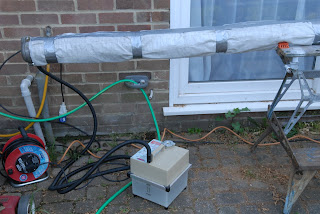Going back to basics - today is the Winter Solstice, the shortest day - the real reason Stonehenge was built. The Sun returns tomorrow - no not the newspaper - that bright shiny thing we don't see too much of in this country. The nights start to draw out again, and summer is on its way.
Of course its perishing cold outside, and damp, so Huntsman 31 rebuilding occurs in the workshop - some of which is shown in the photograph. I calculate about 1% of the detritus in the workshop is in shot.
Most importantly; the fridge box (partially completed) at the bottom, awaiting yet more sanding and resin coating. Top centre is the rebuilt (to modern requirements) secondary electrical panel which will sit in the companionway within reach of the helmsman and provides the main electrical controls for the engine and ancillary equipment like navigation lights; screen wipers etc.
The wiring diagram on the wall is for the aluminium runabout - and copied from an MG-B Haynes manual - don't ask - and nothing to do with the Huntsman, its just that the blue-tack holding it to the wall will probably bring the plaster off if I try to remove the diagram.
Next job is to fit the 2" (50mm) insulation to the fridge box.
So - whether you worship the Sun; Capitalism or other Deity, have a great time. See you in the New Year.
Have a good one...
[Now Playing: Ring Out Solstice Bells (2003 - Remaster) by Jethro Tull]
by Jethro Tull]
















 a start on laying the teak deck. The materials are in stock and I think I know what I'm doing.
a start on laying the teak deck. The materials are in stock and I think I know what I'm doing.




